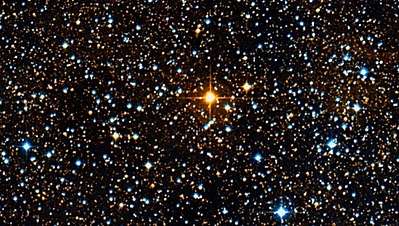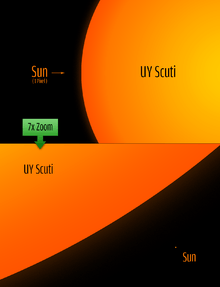UY Scuti
 Dense starfield around the red supergiant star UY Scuti (brightest star in the image) as seen from the Rutherfurd Observatory in the Columbia University in New York, United States. The picture was captured in 2011. | |
| Observation data Epoch J2000 Equinox J2000 | |
|---|---|
| Constellation | Scutum |
| Right ascension | 18h 27m 36.5334s[1] |
| Declination | −12° 27′ 58.866″[1] |
| Apparent magnitude (V) | 8.29 - 10.56[2] |
| Characteristics | |
| Spectral type | M2-M4Ia-Iab[2] |
| U−B color index | +3.29[3] |
| B−V color index | +3.00[4] |
| Variable type | SRc[5] |
| Astrometry | |
| Radial velocity (Rv) | 18.33±0.82[6] km/s |
| Proper motion (μ) | RA: 1.3[7] mas/yr Dec.: −1.6[7] mas/yr |
| Parallax (π) | 0.6433 ± 0.1059[8] mas |
| Distance | approx. 5,100 ly (approx. 1,600 pc) |
| Absolute magnitude (MV) | −6.2[9] |
| Details[3] | |
| Mass | 7–10 M☉ |
| Radius | 1,708±192 R☉ |
| Luminosity | 340,000+290,000 −160,000 L☉ |
| Surface gravity (log g) | −0.5 cgs |
| Temperature | 3,365±134 K |
| Other designations | |
| Database references | |
| SIMBAD | data |
Coordinates: ![]()
Nomenclature and history
UY Scuti was first cataloged in 1860, by German astronomers at the Bonn Observatory, during the first sky survey of stars for the Bonner Durchmusterung Stellar Catalogue.[10] It was named BD-12 5055, the 5,055th star between 12°S and 13°S counting from 0h right ascension.
On the next detection of the star in the second survey, it was found to have changed slightly in brightness, suggesting that it was a new variable star. In accordance with the international standard of designation of variable stars, it was called UY Scuti, the 38th variable star of the constellation Scutum (see variable star designation).[11]
UY Scuti is located a few degrees north of the A-type star Gamma Scuti and northeast of the Eagle Nebula. Although the star is very luminous it is, at its brightest, only 9th magnitude as viewed from Earth, due to its distance and location in the Zone of Avoidance within the Cygnus rift.[12]
Characteristics

UY Sct is a dust-enshrouded red supergiant[13] and is classified as a semiregular variable with an approximate pulsation period of 740 days.[5][14][15]
In the summer of 2012, Arroyo-Torres et al. using AMBER interferometry from the Very Large Telescope (VLT) in the Atacama Desert in Chile measured the parameters of three red supergiants near the Galactic Center region:[3] UY Scuti, AH Scorpii, and KW Sagittarii. They determined that all three stars are over 1,000 times bigger than the Sun and over 100,000 times more luminous than Sun. The stars' sizes were calculated using the Rosseland radius, the location at which the optical depth is 2⁄3,[16] with distances adopted from earlier publications. UY Scuti was found to be the largest and the most luminous of the three stars measured, at 1,708 ± 192 R☉ (1.188×109 ± 134,000,000 km; 7.94 ± 0.89 AU) based on an angular diameter of 5.48±0.10 mas and an assumed distance of 2.9±0.317 kiloparsecs (kpc) (about 9,500±1,030 light-years) which was originally derived in 1970 based on the modelling of the spectrum of UY Sct.[9] The luminosity is then calculated to be 340,000 L☉ at an effective temperature of 3,365 ± 134 K, giving an initial mass of 25 M☉ (possibly up to 40 M☉ for a non-rotating star).[3] Direct measurements of parallax of UY Sct by the Gaia Data Release 2 have recently given a parallax of 0.6433±0.1059 mas, yielding a much lower distance of approximately 1.55 kiloparsecs (5,100 ly), and consequently much lower luminosity and radius values.[8]
A hypothetical object travelling at the speed of light would take about seven hours to travel around UY Scuti at maximum, whereas it would take 14.5 seconds to circle the Sun.[17]
UY Scuti's mass is uncertain, primarily because it has no visible companion star by which its mass can be measured through gravitational interference. However, it is expected to be between 7 and 10 M☉.[3] Mass is being lost at 5.8×10−5 M☉ per year, leading to an extensive and complex circumstellar environment of gas and dust.[18]
Supernova
Based on current models of stellar evolution, UY Scuti has begun to fuse helium, and continues to fuse hydrogen in a shell around the core. The location of UY Scuti deep within the Milky Way disc suggests that it is a metal-rich star.[19]
After fusing heavy elements, its core will begin to produce iron, disrupting the balance of gravity and radiation in its core and resulting in a core collapse supernova. It is expected that stars like UY Scuti should evolve back to hotter temperatures to become a yellow hypergiant, luminous blue variable, or a Wolf–Rayet star, creating a strong stellar wind that will eject its outer layers and expose the core, before exploding as a type IIb, IIn, or type Ib/Ic supernova.[20]
References
- 1 2 Hog, E.; Kuzmin, A.; Bastian, U.; Fabricius, C.; Kuimov, K.; Lindegren, L.; Makarov, V. V.; Roeser, S. (1998). "The TYCHO Reference Catalogue". Astronomy and Astrophysics. 335: L65. Bibcode:1998A&A...335L..65H.
- 1 2 "VSX: Detail for UY Sct". American Association of Variable Star Observers. Retrieved 2018-09-20.
- 1 2 3 4 5 6 Arroyo-Torres, B.; Wittkowski, M.; Marcaide, J. M.; Hauschildt, P. H. (2013). "The atmospheric structure and fundamental parameters of the red supergiants AH Scorpii, UY Scuti, and KW Sagittarii". Astronomy & Astrophysics. 554: A76. arXiv:1305.6179. Bibcode:2013A&A...554A..76A. doi:10.1051/0004-6361/201220920.
- ↑ Ducati, J. R. (2002). "VizieR Online Data Catalog: Catalogue of Stellar Photometry in Johnson's 11-color system". CDS/ADC Collection of Electronic Catalogues. 2237: 0. Bibcode:2002yCat.2237....0D.
- 1 2 Kholopov, P. N.; Samus, N. N.; Kazarovets, E. V.; Perova, N. B. (1985). "The 67th Name-List of Variable Stars". Information Bulletin on Variable Stars. 2681: 1. Bibcode:1985IBVS.2681....1K.
- ↑ "VizieR Online Data Catalog: Gaia DR2 (Gaia Collaboration, 2018)". Vizier Online Data Catalog: I/345. 2018. Bibcode:2018yCat.1345....0G.
- 1 2 Høg, E.; Fabricius, C.; Makarov, V. V.; Urban, S.; Corbin, T.; Wycoff, G.; Bastian, U.; Schwekendiek, P.; Wicenec, A. (2000). The Tycho-2 catalogue of the 2.5 million brightest stars. Astronomy and Astrophysics. 355. pp. L27. Bibcode:2000A&A...355L..27H. doi:10.1888/0333750888/2862. ISBN 978-0333750889.
- 1 2 Brown, A. G. A.; et al. (Gaia collaboration) (August 2018). "Gaia Data Release 2: Summary of the contents and survey properties". Astronomy & Astrophysics. 616. A1. arXiv:1804.09365. Bibcode:2018A&A...616A...1G. doi:10.1051/0004-6361/201833051.
- 1 2 Lee, T. A. (1970). "Photometry of high-luminosity M-type stars". Astrophysical Journal. 162: 217. Bibcode:1970ApJ...162..217L. doi:10.1086/150648.
- ↑ "UY Scuti - Universe Guide". Universe Guide. Retrieved 15 January 2016.
- ↑ Prager, R. (1927). "Katalog und Ephemeriden veraenderlicher Sterne fuer 1927". Kleine Veroeffentlichungen der Universitaetssternwarte zu Berlin Babelsberg. 1: 1.i. Bibcode:1927KVeBB...1....1P.
- ↑ "UY Sct (UY Scuti)". kusastro. Retrieved 15 January 2016.
- ↑ Van Loon, J. Th.; Cioni, M.-R. L.; Zijlstra, A. A.; Loup, C. (2005). "An empirical formula for the mass-loss rates of dust-enshrouded red supergiants and oxygen-rich Asymptotic Giant Branch stars". Astronomy and Astrophysics. 438: 273–289. arXiv:astro-ph/0504379. Bibcode:2005A&A...438..273V. doi:10.1051/0004-6361:20042555.
- ↑ Whiting, Wendy A. (1978). "Observations of Three Variable Stars in Scutum". The Journal of the American Association of Variable Star Observers. 7 (2): 71. Bibcode:1978JAVSO...7...71W.
- ↑ Jura, M.; Kleinmann, S. G. (1990). "Mass-losing M supergiants in the solar neighborhood". The Astrophysical Journal Supplement Series. 73: 769. Bibcode:1990ApJS...73..769J. doi:10.1086/191488.
- ↑ Wehrse, R.; Scholz, M.; Baschek, B. (June 1991). "The parameters R and Teff in stellar models and observations". Astronomy and Astrophysics. 246 (2): 374–382. Bibcode:1991A&A...246..374B.
- ↑ "Solar System Exploration: Planets: Sun: Facts & Figures". NASA. Archived from the original on January 2, 2008. Retrieved 15 January 2016.
- ↑ Sylvester, R. J.; Skinner, C. J.; Barlow, M. J. (1998). "Silicate and hydrocarbon emission from Galactic M supergiants". Monthly Notices of the Royal Astronomical Society. 301 (4): 1083–1094. Bibcode:1998MNRAS.301.1083S. doi:10.1046/j.1365-8711.1998.02078.x.
- ↑ Meynet, Georges (2008). Israelian, Garik, ed. The metal-rich universe. Cambridge: Cambridge University Press. ISBN 9780521879989. Retrieved 15 January 2016.
- ↑ Groh, Jose H.; Meynet, Georges; Georgy, Cyril; Ekström, Sylvia (2013). "Fundamental properties of core-collapse supernova and GRB progenitors: Predicting the look of massive stars before death". Astronomy & Astrophysics. 558: A131. arXiv:1308.4681. Bibcode:2013A&A...558A.131G. doi:10.1051/0004-6361/201321906.